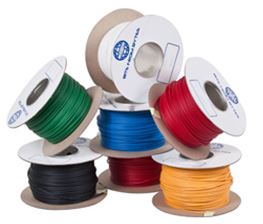All around us we see the growing presence of 3D printers and marvel at the creations made by 3D printing. Two of the most common thermoplastics used for 3D printing are PLA and ABS. ABS in particular is a favorite among engineers with mechanical uses in mind due to its strength, flexibility, machinability, and higher temperature resistance.  This last point, the higher temperature resistance, implies also that you need to use a heated platform, often heated to its maximum temperature when working with ABS. Regardless of whether the 3D printing platform is heated or not, you want to make sure that it is always level to avoid headaches later on. For this reason, it should always be covered with a tape for best results. Between builds, the tape should be removed and reapplied, meaning that you also want to have a tape that doesn’t leave much residue after removal. Excess adhesive can be cleaned with rubbing alcohol.
This last point, the higher temperature resistance, implies also that you need to use a heated platform, often heated to its maximum temperature when working with ABS. Regardless of whether the 3D printing platform is heated or not, you want to make sure that it is always level to avoid headaches later on. For this reason, it should always be covered with a tape for best results. Between builds, the tape should be removed and reapplied, meaning that you also want to have a tape that doesn’t leave much residue after removal. Excess adhesive can be cleaned with rubbing alcohol.
Is Kapton tape, polyimide tape or blue painter’s tape best for my 3D printing platform?
Depending on the plastic you are printing, different tapes can be used. ABS printing requires a high temperature resistant tape, and Kapton tape (DuPont’s brand name), or the generic version polyimide tape is the product best used for this application. The reason polyimide tape is so well suited to the heated platform of the 3D printer is because it can easily withstand the heating and the cooling of the platform. CAPLINQ manufactures many types of polyimide tapes, and I will later outline the best polyimide tapes for 3D printing ABS plastic. A less expensive tape, often called “Blue Painter’s Tape” or blue polyester tape can be used for PLA printing since it does not need the high temperature resistance. CAPLINQ also manufactures this blue polyester tape and I will recommend specific products in a later section. If you are going to be using your 3D printer for both ABS printing and PLA printing and only want to use one tape, then you should use the polyimide tape, as it can be used for both printer applications.
High Temperature Polyimide Tape for 3D Printing of ABS Plastic
CAPLINQ manufactures a wide range of polyimide tapes, each with different backing thicknesses, adhesive types, release liners and treatment layers. When doing 3D printing of ABS however, what you should be concerned about with your polyimide tape is:
- Make sure it is thick enough. 2 mil is a perfect thickness for the heat cycles and to ensure a smooth working surface.
- Make sure it can withstand high temperatures
- Make sure it doesn’t bubble when applied
- Make sure that it removes easily and that residues come off easily with rubbing alcohol
With these criteria in mind, these are the products that are recommended for the 3D printer platform when printing ABS plastic. Each of them are available as “Jumbo Rolls” that are 508mm (20 inches) wide that you can slit yourself, or you can order them pre-slit to your desired widths:
- PIT2S: This product is simply a 2-mil polyimide tape with a low residue adhesive
- PIT2S-RL: This is the same as the PIT2S except it is on a stand-alone release liner
- PIT2N: This product is the same as the PIT2S, but has no adhesive at all
High(ish) Temperature Polyester Tape (a sort of blue painter’s tape) for 3D Printing of PLA Plastic
PLA does not require the high temperature resistance of ABS printing. You also do not need to have the same thickness as with polyimide. In most cases (probably all, but I may not be thinking of it just now), PET1S: 1 mil blue polyester tape with low adhesive will be perfect. As with the polyimide tape, we offer it in jumbo rolls of 508mm (20 inches), or you can have it pre-slit to your specific sizes.
For more information, you can consult our complete list of polyimide tapes, or you can compare our polyimide films and tapes. Should you have any other questions, please contact us or visit the CAPLINQ website today to find out more, or for more information.

